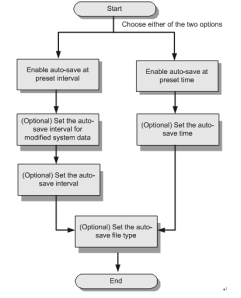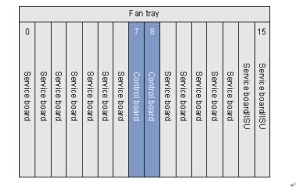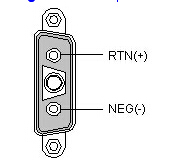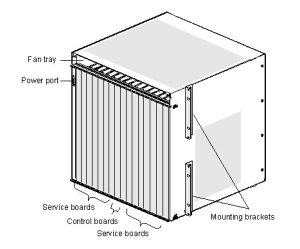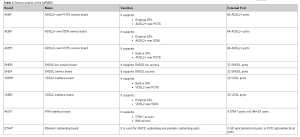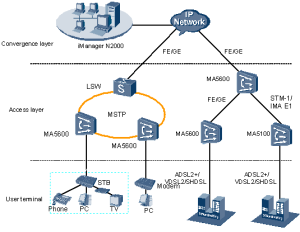1 Abundant Port Types
The Huawei MA5600 provides various network ports, service ports, and maintenance ports to meet different networking requirements.
Table 1 lists the ports provided by the MA5600.
| Port Type |
Port Name |
Remarks |
| Network port |
FE optical and electrical port |
The network port supports the electrical port, single-mode optical port, and multi-mode optical port. They are used to:
- Connect to the upper layer device.
- Subtend shelf.
|
| GE optical and electrical port |
| Service port |
ADSL2+ port |
It is compatible with ADSL, and its performance is better than ADSL with respect to:
- Higher rate.
- Longer distance.
- Lower power consumption.
- More stable operation.
|
| SHDSL port |
It supports the symmetrical transmission.
The transmission reach ranges from 3 km to 6 km. |
| VDSL2 port |
It supports:
- Discrete multi-tone (DMT) technology.
- Compatibility with ADSL2+.
|
| Ethernet port |
It provides subtending of the MA5600 shelves. |
| ATM port |
It supports:
- STM-1 port.
- IMA port.
- ATM access.
|
| Maintenance port |
Maintenance serial/network port |
These ports are used for local and remote maintenance. |
| Environment monitoring port |
Through the port, various environment parameters collected by the monitoring device are reported to the host. |
2 Flexible Networking
As a multi-service access platform, the MA5600 supports multiple access modes and networking modes to suit various networking scenarios in different environments and to meet different service requirements.
The MA5600 provides the following networking solutions:
- Broadband multi-service access solution
The MA5600 supports the xDSL access solution. In addition, the MA5600 supports subtending networking configurations through the Ethernet ports.
Triple play subscribers, including PPPoE subscribers, VoIP subscribers, and video subscribers, are connected to the MA5600 through the home gateway. After processing the service packets from these subscribers, the MA5600 transmits the packets to the upper layer device.
For terminals using the asynchronous transfer mode (ATM), such as an ADSL2+ terminal, the MA5600 supports single–permanent virtual connection (single-PVC) and multi-PVC to implement the triple play networking configuration. For terminals using the packet transfer mode (PTM), such as a VDSL2 terminal, the MA5600 also supports VLAN based triple play networking configuration.
- Private line interconnection solution
The MA5600 provides private line interconnection services for enterprise subscribers. Enterprise subscribers are connected to the MA5600 in the ADSL2+/SHDSL/VDSL2 mode. The private line interconnection can provide the transparent transmission of the private VLAN and services to the peer end.
3 Operable IPTV Services
The MA5600 has the following carrier-class multicast features: service switching capacity of up to 48 Gbit/s, packet forwarding capability of up to 72 Mbit/s, and high integration of data switching, routing, and user management. The MA5600 supports a complete range of multicast protocols from the subscriber side to the network side. This provides a foundation for operability and manageability of broadband multicast services.
Multicast Protocols
The supported multicast protocols are as follows:
- Internet Group Management Protocol (IGMP) V2/V3
- IGMP proxy and IGMP snooping
- Protocol Independent Multicast (PIM) and Source-Specific Multicast (SSM)
Multicast Services
The multicast services are as follows:
- Supporting up to 1000 multicast groups
- Supporting VLAN-based multicast
- Supporting 256 multicast VLANs
- Supporting dynamically generating multicast programs
- Supporting viewing up to 16 programs at the same time for a subscriber
- Supporting easy channel management
- Supporting configuring the maximum number of preview times in a day
- Supporting the audience statistics
- Supporting IGMP pre-join and fast-leave
- Supporting the IGMP high performance processing that enables broadband TV (BTV) over xDSL
- Supporting fast-leave based on MAC address control
Subscriber Management
The subscriber management functions are as follows:
- Rich authentication modes on multicast subscribers to suit different multicast operators
- Controllable multicast to control the access of subscribers to multicast groups
- Connection admission control (CAC) for multicast subscribers to ensure that authenticated subscribers can enjoy guaranteed QoS
- Interconnection between the transaction language 1 (TL1) interface of the NMS and the operating support system (OSS) to solve the multicast authority control problem in the operation and management of the multicast service
4 Dynamic Line Optimization Function
The MA5600 works with the N2510 line assurance system (N2510 for short) to implement the dynamic line management (DLM) functions. The N2510 optimizes the line profile of the MA5600 through the optimization profile. In this way, the line is dynamically optimized.
NOTE:
The N2510 is developed by Huawei and is intended for the line test and QoS guarantee for the copper cables of operators. The N2510 guarantees line services and locates line faults when it is functioning. It also provides excellent line management solutions, meets the line analysis and management requirements of operators, and reduces the operation expenditure (OPEX).
By working with the N2510, the MA5600 implements the following functions:
- Quickly diagnoses and analyzes the digital subscriber line (DSL) network conditions and rectifies the fault.
- Guarantees the quality of the DSL network and lines, and improves the service quality for subscribers.
- Increases the rates of the services in the entire network, and introduces new services that require broader bandwidth and higher line quality.
DLM
The DLM refers to dynamic line management. When the MA5600 works with the N2510, the N2510 automatically adjusts the line parameters of a single line and implements the following functions:
- Guarantees high stability and performance of a single DSL, and improves the stability and performance of the DSL services on each port.
- Reduces the cost for maintaining the loop line.
5 Strict Security
In line with the security requirements for carrier-class telecom services, the MA5600 provides the following features to ensure the security of the system and the user.
System Security
The MA5600 provides the following system security measures:
- Prevention of denial of service (DoS) attacks
- Prevention of Internet Control Message Protocol (ICMP) or IP packet attacks
- Firewall and access control list (ACL)-based access control
- Media access control (MAC) address filtering
- Secure sell (SSH) V2
- Remote authentication dial in user service (RADIUS) authentication of management users
- Hierarchical authority control of management users
User Security
The MA5600 provides the following user security measures:
- User isolation in layer 2 (L2)
- Access control based on the IP address segment
- Prevention of MAC spoofing
- Prevention of VLAN-based IP/MAC address spoofing
- Prevention of the IP address spoofing of the DHCP user
- Dynamic Host Configuration Protocol (DHCP) Option82, enhancing the DHCP security
- PPPoE access identification
- Binding between MAC/IP addresses and service ports
6 Carrier-Class Reliability
The abnormality processing capability is taken into consideration in the system, software, and networking designs. This ensures the reliable running of the MA5600.
System Design
The following are the outstanding features of system design of the MA5600:
- The system design complies with carrier-class reliability indexes.
- The system has comprehensive exception handling capabilities.
- The system is self-healing, which offers a mean time between failures (MTBF) of more than 150,000 hours.
- The system has passed the electrostatic discharge (ESD) test.
- The system features the lightning proof and the anti-interference functions.
- The system offers diverse alarm information for quick fault detection and rectification.
- The system supports remote maintenance.
- The system supports component normalization in selection and control.
- Component design of the device is up to the derating design and meets the reliability requirement.
Integrated Equipment Design
The following are the important features related to the integrated equipment design of the MA5600:
- The system complies with the RoHS requirement.
- The environment adaptation index complies with the related requirements of the European Telecommunications Standards Institute (ETSI).
- The electromagnetic compatibility (EMC) index complies with the standard of the ETSI EN 300 386, and meets the CE authentication.
- Security specification index complies with the security standards, such as the UL60950-1, IEC60950-1, and IEC60825-1/2.
Hardware Design
The following are the important features related to the hardware design of the :
- The system backs up the important hardware unit.
- The system supports the active/standby switchover.
- The system supports the uplink protection and backup.
- All service boards and the control board are hot swappable.
Software Design
The following are the important features related to the software design of the MA5600:
- Modularized and platform-based design
- Loose coupling software design
- Advanced design methods such as object-orientation, fault tolerance, fault correction, and automatic recovery
- Compliance with capability maturity model (CMM)
- Smooth online software upgrading
- Rollback of the software version
Heat Dissipation Design
The following are the important features related to the heat dissipation design of the MA5600:
- The heat dissipation system provides a redundancy backup to ensure the service running when a fan is faulty.
- The fans adopts air exhaust mode or blowing mode, and the fans are hot swappable.
- The host software supports controlling the fan speed.
7 Superior Maintainability and Manageability
The MA5600 supports excellent management, maintenance, and monitoring functions that facilitate routine maintenance and fault detection.
Rich Maintenance Means
- The MA5600 can be maintained from a local terminal through the command line interface (CLI).
- The MA5600 can be maintained through the N2000 BMS (both the inband mode and the outband mode).
- The MA5600 supports management based on the Simple Network Management Protocol (SNMP), allowing the N2000 BMS to provide centralized network management.
- The system supports reporting the hardware version and software version online, real-time upgrading and loading the board software and host software online, and real-time loading and managing the patch online.
- The system supports super patches (including independent patches and cold patches).
- The system supports capturing PPPoE downstream packets based on VLAN.
Multiplex System Maintenance
The system supports the following system maintenance features:
- Display of the user label information in the reported alarm
- SNMP V2/V3
- Broadband test, used to provide reference for the xDSL line and locate the fault on the line or central offices
- Log access, used to maintain the device or locate the problem
- Time zone configuration and daylight configuration
- Network Time Protocol (NTP) clock synchronization
- Remote packet capture to fast collect the information about the remote end
- One-key information collection to easily collect debugging information about the LSW chip at the remote end
- Full-flow packet statistics to improve the efficiency of locating faults and problems
Rich Management Interfaces
- The N2000 BMS provides various southbound interfaces such as Telnet and SNMP to connect to the managed devices.
- The N2000 BMS provides standardized SNMP and TL1 northbound interfaces to support automation functions, such as alarm, topology, service, inventory resource, and test for the OSS and the management system in the network layer. This helps carriers create unified network monitoring and automatic service supporting platform.
Security Management
The N2000 BMS supports sufficient user management and authentication functions for managing the shelves and boards of the managed devices.
Environment Monitoring
The MA5600 provides environment monitoring ports. These ports connect to the environment monitoring module through special cables. In this way, the environment data, such as temperature, humidity, power supply voltage, smog, and fan state can be collected. This helps implement remote or unattended maintenance.
Software Upgrade
The control board supports online upgrade in addition to the version rollback operation in case of an upgrade failure. The MA5600 supports upgrading the patch for the board software. The MA5600 adopts the smooth upgrade to upgrade devices. You can upgrade the software through any of the following methods:
- A serial port based on Xmodem
- An Ethernet port based on Trivial File Transfer Protocol (TFTP), Secure File Transfer Protocol (SFTP) and File Transfer Protocol (FTP)
Performance Measurement
The N2000 BMS can collect, query, and analyze the performance data of the equipment.
More related:
